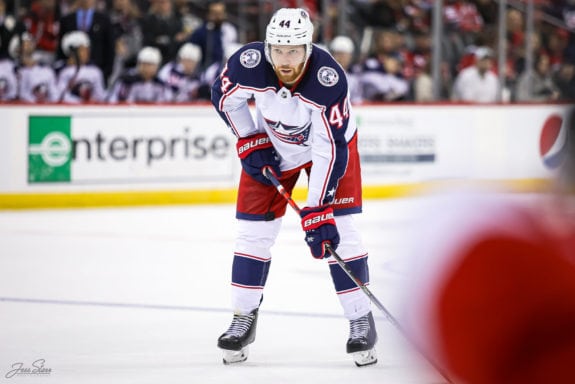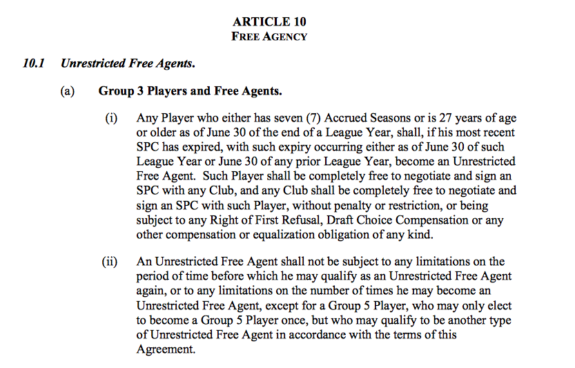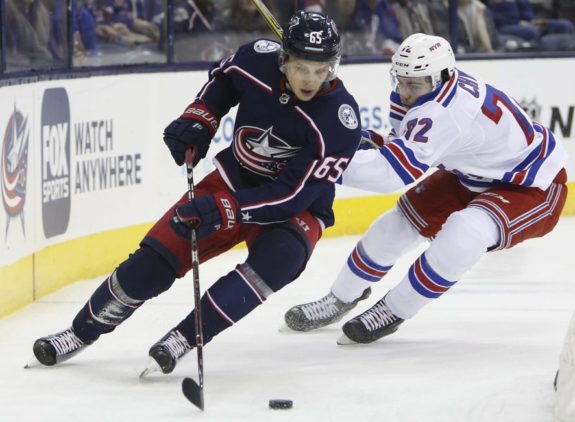In the summer of 2021, the NHL’s newest team, the Seattle Kraken, will be formed through an expansion draft. This draft will use the same rules as those for the expansion draft that created the Vegas Golden Knights in 2017. Each existing team, except the Golden Knights, will lose one player. Each of those teams must make agonizing decisions about which players to protect from the draft. The Columbus Blue Jackets may not need to worry about losing young defenseman Vladislav Gavrikov – under the rules for the draft, he should be exempt.

Stories and articles about the expansion draft have been circulating for over a year already. Many have the Blue Jackets using one of their limited “protected” slots for Gavrikov. Other “mock drafts” show Columbus leaving Gavrikov exposed to the draft and being selected by the Kraken. (from ‘Mock drafting Seattle’s NHL expansion team,’ Georgetown Voice, 07/11/2020)
However, a close reading of the rules for the draft and the Collective Bargaining Agreement (CBA) between the NHL and the NHL Players’ Association shows that Gavrikov will be exempt as a player with only two years of NHL experience (and no AHL experience) when the expansion draft happens.
What are the Rules of the Expansion Draft?
Seattle will select players from existing NHL teams (except Vegas) to form the new Krakens. Each team will lose one player from its unprotected list. Teams can protect from the draft a combination of seven forwards plus three defensemen and one goalie or, if they choose, eight skaters (any combination of forwards and defensemen) plus one goalie. A couple of caveats pertain to which players are protected:
- All players with no movement clauses at the time of the draft, and who decline to waive those clauses, must be protected and will be counted toward their team’s applicable protection limits.
- All first and second-year NHL players, and all unsigned draft choices, will be exempt from selection (and will not be counted toward protection limits).
It’s this second clause that pertains to Gavrikov. Most prognosticators assume him to be a third-year NHL player at the time of the expansion draft. After all, his stats show him playing in the NHL in two seasons already, and next year will be the third. He appeared in a couple of playoff games for Columbus in 2018-19, played 69 regular season and 10 playoff games in 2019-20, and – barring something totally unexpected – will play in the NHL during the 2020-21 season (whether for the Blue Jackets or another team).
Related: Seattle Mock Expansion Draft: Win Now Team
His contract is expiring and he then becomes a Restricted Free Agent (RFA). Under the terms of the CBA, his “expiry status” falls under Article 10.2(c), “Players With Fewer Than Three Years of Professional Experience.” But as his contract expires in 2020, does he have two years of experience already or only one? If he already has two years’ experience, then next season counts as his third and at the end, when the expansion draft rolls around, he no longer falls under the exemption for “first- and second-year NHL players.”

The Blue Jackets, then, would either need to include him as one of their three protected defensemen (or eight skaters of any position) or leave him exposed in the expansion draft, ripe for Seattle to swoop in and pick him up. But if the 2018-19 season did not count as a year in the NHL, he remains exempt under the “first- or second-year NHL players” clause.
What Constitutes a “Year” of Experience Under the CBA?
The CBA is a rather dense legal document that runs to over 500 pages. And that’s not counting the 71-page “memorandum of understanding,” which extended the existing CBA by four years (Both can be downloaded here). According to the CBA:
[A] Player aged 18 or 19 earns a year of professional experience by playing ten (10) or more NHL Games in a given NHL Season, and a Player aged 20 or older (or who turns 20 between September 16 and December 31 of the year in which he signs his first SPC) earns a year of professional experience by playing ten (10) or more Professional Games under an SPC in a given League Year.
–CBA, Article 10.2(a)(i)(A)
Let’s assume that nothing tragic happens and Gavrikov does play more than 10 games for Columbus (or another NHL team) during the 2020-21 season. That counts as “a year of professional experience.” The 2019-20 season definitely fits that bill – he played a total of 79 regular and postseason games.
Related: 7 Biggest NHL Players in Today’s Game
But what about his NHL experience from 2018-19? He played only two postseason games, and did not meet the 10 game minimum as specified in the CBA. Therefore, 2018-19 does not count as “a year of professional experience.” Therefore, at the end of the 2020-21 season Gavrikov will still fall under the expansion draft exemption for “all first- and second-year NHL players.”
What Does This Means for the Blue Jackets?
Since Gavrikov will be exempt from the draft, Columbus doesn’t need to use one of their limited “protected” spots to keep him from being selected by the Kraken. That frees up the team to protect another defenseman. There is little doubt – no, make that “no” doubt – that the Blue Jackets will protect star defensemen Seth Jones and Zach Werenski. After that, general manager Jarmo Kekalainen and his team have a decision to make.

Since they can protect three defensemen (unless the team elects the eight-plus-one option, which is unlikely), they can protect any one of Dean Kukan, Markus Nutivaara, Scott Harrington, or a couple of less likely options. Defensemen Ryan Murray and David Savard will be unrestricted free agents at the end of 2020-21. If they are under contract, they also fall into consideration as the third protected defenseman.

Promising young defenseman Andrew Peeke is exempt from the draft under the “first- and second-year” clause. As should be Gavrikov. Read the CBA and expansion draft rules. Gavrikov should be exempted as a second-year player when Seattle makes its selections in the 2021 expansion draft.